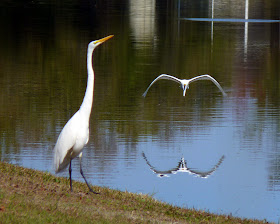I have fond memories as a kid of getting the Sears Christmas Wish Book every year in late fall - it had page after page of the toys and games that would soon find their way onto our lists for Santa. My brother and I would pore over the catalog, separately and apart, revisiting our favorite choices over and over until the pages were worn. The dream of what we might get was almost better than the delight of Christmas morning.

As an adult gardener, I find the same delight each winter as the spring seed catalogs begin pouring in. Page after page of blooms and vegetables and fruits, new pleasures and old favorites, bright colors and promised fragrances... I keep them by my chair on dark winter evenings and pore through them page by page. I dog-ear the pages, compare options between catalogs, and dream dream dream about bringing all that color and life from the pages of the catalogs into My Florida Backyard. The catalogs are free, but the pleasure they provide is priceless when winter nights seem long.
I don't always have a lot of luck starting plants from seeds, but every year I allow myself a budget and, after much careful research, give some seeds a try. As a Florida gardener, I know that many of the blooms offered in the catalogs might not grow here, so I spend time on sites like
Dave's Garden finding out if others in similar areas have raised this plant successfully. I check the
FLEPPC's list of Invasive Species to be sure I don't accidentally introduce something into the ecosystem that could do more harm than good. I decide if there's really a place for each plant in My Florida Backyard, and determine the potential wildlife value - when you have a fraction of an acre, every square foot counts.
Then I make my lists. I visit each catalog's website, and fill my shopping cart with every seed that made it through the research phase. Then, I start making the hard decisions; if I bought every seed that caught my eye, I'd spend hundreds of dollars and couldn't possibly accommodate all the plants. So I winnow the lists down, slowly, over days, until my mind is made up. And then... I click "Buy" and wait for my little packets of dreams to arrive in the mail.
Here are just five of the seeds that are catching my eye this year, and the catalog offering them (pictures come from those catalogs websites). We here in My Florida Backyard would love to hear about your own experiences with any of these, especially from those living in zone 9a or 9b.
Gaillardia, Punch Bowl Hybrid (Burpee)
We have tons of luck each spring with perennial
Gaillardia pulchella, also known as Indian Blanket or Blanketflower. We threw down a packet of seeds a few years ago, and they come back over and over and over again. This makes us hopeful that this lovely pink variety might also thrive. These seeds are a little pricey at $4.95 for a packet of 100, but if they thrive year after year like the gaillardia we have now, they'd be cheap at twice the price.
Marigold, Snowball Hybrid (Burpee)
We're not really crazy about marigolds in general, but something about this white variety is really striking, and marigolds are pretty easy to start from seed. Marigolds tend to hold up pretty well to even Florida's brutal heat, so we could definitely see these finding a home in our low-maintenance front yard. On the other hand, these are another fairly expensive (for seed) option - $5.50 for 50 seeds, and marigolds are definitely an annual, so this wouldn't be something we'd get benefit from in the future.
 Vinca, First Kiss Blueberry (Park Seed)
Vinca, First Kiss Blueberry (Park Seed)
Vinca (also called periwinkle) grows easily from seed. We love the white and pink shades, and this new purple hue is really wonderful. Vinca withstands heat and while it may die back in a frost, it often comes back from the roots in My Florida Backyard. At $2.25 for a packet of 50, this is a great investment, as we'd expect to find these in the garden for years to come.
Salvia farinacea, Fairy Queen (Park Seed)
Salvia is incredibly popular in our butterfly garden, and perennial
S. farinacea is one of our favorites. It survives crushing heat and a frost or two, coming back year after year, and the blooms are a constant draw for butterflies. This variety is a bi-color mix of blue and white, and at $2.25 per packet, seems a good value.
Monarda Bergamo (Park Seed)
When we were in Ohio last summer, we saw a patch of
monarda (bee balm) absolutely covered with Hummingbird Clearwing Moths, and it made us want some for our own yard. However, most monarda varieties struggle with Florida's steamy summers, being very susceptible to mildew. (
The exception is our native Monarda punctata.) "Bergamo" claims to be mildew-resistant, and a packet of 50 seeds is only $1.95, so it seems worth a try.
There are plenty of other seeds that are on our radar for 2011, so we'll see what happens when we finally place those seed orders. What seed catalogs do you love? Tell us, so we can get them and find out what we're missing!



























